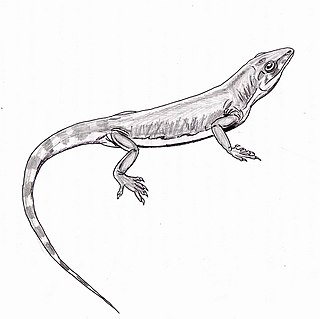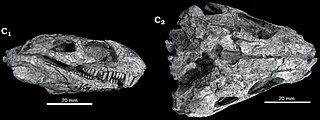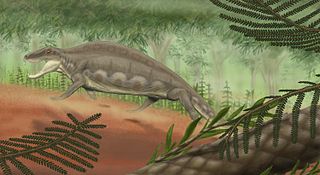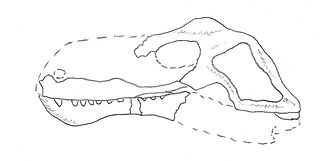
Synapsids are a group of animals that includes mammals and every animal more closely related to mammals than to the other members of the amniote clade, such as reptiles and birds. Unlike other amniotes, they have a temporal fenestra, an opening low in the skull roof behind each eye, leaving a bony arch beneath each; this accounts for their name. Primitive synapsids are usually called pelycosaurs or pelycosaur-grade synapsids. This informal term consists of all synapsids that are not therapsids, a monophyletic, more advanced, mammal-like group. The non-mammalian synapsids were described as mammal-like reptiles in classical systematics, but this misleading terminology is no longer in use as synapsids as a whole are no longer considered reptiles. They are now more correctly referred to as stem mammals or proto-mammals.

Therapsida is a major group of eupelycosaurian synapsids that includes mammals and their ancestors. Many of the traits today seen as unique to mammals had their origin within early therapsids, including limbs that were oriented more underneath the body, as opposed to the sprawling posture of many reptiles and salamanders. The earliest fossil attributed to Therapsida used to be Tetraceratops insignis from the Lower Permian. However, in 2020 a study concluded that Tetraceratops is not a true therapsid, but should be considered a member of the more ancient Sphenacodontia, from which the therapsids evolved.

The pelycosaurs were previously considered an order, but are now only an informal grouping composed of basal or primitive Late Paleozoic synapsids, formerly called mammal-like reptiles. They consist of all synapsids excluding the therapsids and their descendants.

Eupelycosauria is a large clade of animals characterized by the unique shape of their skull, encompassing all mammals and their closest extinct relatives. They first appeared 308 million years ago during the Early Pennsylvanian epoch, with the fossils Archaeothyris and perhaps an even earlier genus, Protoclepsydrops, representing just one of the many stages in the evolution of mammals, in contrast to their earlier amniote ancestors.

Varanopidae is an extinct family of amniotes that resembled monitor lizards and may have filled a similar niche, hence the name. Typically, they are considered synapsids that evolved from an Archaeothyris-like synapsid in the Late Carboniferous. However, some recent studies have recovered them being taxonomically closer to diapsid reptiles. A varanopid from the latest Middle Permian Pristerognathus Assemblage Zone is the youngest known varanopid and the last member of the "pelycosaur" group of synapsids.
Caseopsis is an extinct genus of large pelycosaurs that was about 3 metres (10 ft) long. Caseopsis lived in the late Early Permian epoch, before the pelycosaurs were replaced by the more advanced therapsids. It was a lightly built, agile creature. It may have been possible for this species to outpace and escape large predators such as Dimetrodon.

Varanosaurus is an extinct genus of early pelycosaur synapsid that lived during the Kungurian.
Casea is an extinct genus of medium to large-bodied, herbivorous, pelycosaur synapsids from the late Carboniferous until the middle Permian. The name Casea references its appearance from the Caseasauria which developed new morphology of their external naris and snout. Casea were known to be about 1.2 meters long. It weighed between 150 kg to 200 kg. It was slightly smaller than the otherwise very similar Caseoides. Casea was one of the first amniote herbivores, sharing its world with animals such as Dimetrodon and Eryops. It was possibly also aquatic.

Eothyris is a genus of extinct synapsid in the family Eothyrididae from the early Permian. It was a carnivorous insectivorous animal, closely related to Oedaleops. Only the skull of Eothyris, first described in 1937, is known. It had a 6-centimetre-long (2.4-inch) skull, and its total estimated length is 30 centimetres. Eothyris is one of the most primitive synapsids known and is probably very similar to the common ancestor of all synapsids in many respects. The only known specimen of Eothyris was collected from the Artinskian-lower.
Angelosaurus was a basal synapsid in the family Caseidae. The type species, Angelosaurus dolani, is known from a partial skull from the Middle San Angelo Formation, Knox County, Texas, USA dating from the Kungurian. The specimen represented an individual that was from three to three and a half metres long and weighed about 300 kilograms. Like its contemporary Cotylorhynchus, another caseid, it was large, heavily built, and herbivorous. It also shared its environment with the caseids Caseoides and Caseopsis. It may have been preyed upon by the large sphenacodont pelycosaur Dimetrodon.

Ctenorhachis is an extinct genus of the family Sphenacodontidae. Ctenorhachis was related to Dimetrodon, but did not belong to the same subfamily as Dimetrodon and Sphenacodon, being a more basal member of Sphenacodontidae. Ctenorhachis lived in the Early Permian epoch. Two specimens are known that have been found from the Wichita Group outcropping in Baylor and Archer counties, north-central Texas. Only the vertebrae and pelvis are known. Articulated vertebrae from the holotype specimen possess blade like neural spines that are greatly enlarged, although not nearly to the extent that can be seen in more derived sphenacodontds such as Dimetrodon and Secodontosaurus, in which they form a large sail. The pelvis is nearly identical to that of Dimetrodon. As suggested in the original description of the genus, Ctenorhachis may represent a short-spined sexual dimorph, although the authors find this unlikely.
Thrausmosaurus is a genus of synapsid pelycosaurs from the extinct family Varanopidae. Like all that resemble members of Varanopidae, Thrausmosaurus most likely resembled the modern monitor lizard and may have had the same lifestyle. The type and only species was described by R. C. Fox in 1962, from three fossilized jaw fragments bearing teeth. The specimens were recovered from the fissure-fill deposits uncovered in a Limestone Quarry, north of Fort Sill, Comanche County, Oklahoma, USA. These deposits are dated to the Kungurian (Leonardian) of the Lower Permian.

Aerosaurus is an extinct genus within Varanopidae, a family of non-mammalian synapsids. It lived between 252-299 million years ago during the Early Permian in North America. The name comes from Latin aes (aeris) “copper” and Greek sauros “lizard,” for El Cobre Canyon in northern New Mexico, where the type fossil was found and the site of former copper mines. Aerosaurus was a small to medium-bodied carnivorous synapsid characterized by its recurved teeth, triangular lateral temporal fenestra, and extended teeth row. Two species are recognized: A. greenleeorum (1937) and A. wellesi (1981).

Dimacrodon is an extinct genus of non-mammalian synapsid from the latest Early Permian San Angelo Formation of Texas. It is distinguished by toothless, possibly beaked jaw tips, large lower canines and a thin bony crest on top of its head. Previously thought to be an anomodont therapsid related to dicynodonts, it was later found to lack any diagnostic features of anomodonts or even therapsids and instead appears to be a 'pelycosaur'-grade synapsid of uncertain classification.
Eosyodon is a dubious genus of extinct non-mammalian synapsids from the Permian of Texas. Its type and only species is Eosyodon hudsoni. Though it was originally interpreted as an early therapsid, it is probably a member of Sphenacodontidae, the family of synapsids that includes Dimetrodon.
Elliotsmithia is a small varanopid synapsid found from the late Middle Permian of South Africa. It is the sole basal synapsid "pelycosaur" known from the supercontinent Gondwana and only two specimens have been yielded to date. Its species name longiceps is derived from Latin, meaning "long head". Both known Elliotsmithia fossils were recovered from Abrahamskraal Formation rocks—within the boundaries of the Tapinocephalus Assemblage Zone—of the lower Beaufort Group.
Knoxosaurus is an extinct genus of non-mammalian synapsids containing the species Knoxosaurus niteckii that existed approximately 279.5 to 268 million years ago. It was named by American paleontologist Everett C. Olson in 1962 on the basis of fragmentary fossils from Middle Permian-age deposits in the San Angelo Formation of Texas in the United States. Olson placed Knoxosaurus in a new infraorder called Eotheriodontia, which he considered a transitional group between the more reptile-like "pelycosaurs" and the more mammal-like therapsids. Knoxosaurus and Olson's other eotheriodonts were later considered to be undiagnostic remains of basal synapsids, no more closely related to therapsids than are other pelycosaur-grade synapsids.

Cryptovenator is an extinct genus of sphenacodontid pelycosaurs which existed in Germany during the latest Carboniferous. It is known from the holotype LFN−PW 2008/5599−LS, an anterior right mandible fragment, recovered from a dark, fine grained sandstone of the middle Remigiusberg Formation. It was first named by Jörg Fröbisch, Rainer R. Schoch, Johannes Müller, Thomas Schindler and Dieter Schweiss in 2011 and the type species is Cryptovenator hirschbergeri.
Homodontosaurus is an extinct genus of therocephalian therapsids from the Late Permian of South Africa. The type species Homodontosaurus kitchingi was named by South African paleontologist Robert Broom in 1949. Broom based his description on a small skull found in the Cistecephalus Assemblage Zone near Graaff-Reinet. The skull is very small, at about 55 millimetres (2.2 in) long and 20 millimetres (0.79 in) wide. Homodontosaurus has large eye sockets and an elongated snout. The lower jaw is long, thin, and curved. Numerous small teeth line the upper jaw and are long, pointed, and round in cross-section.














